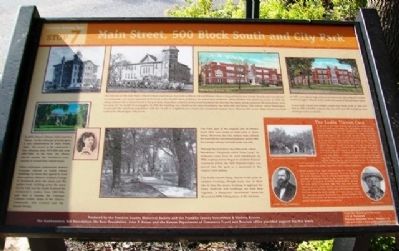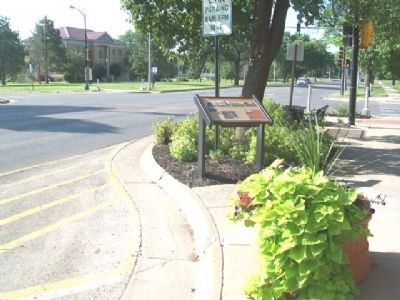Ottawa in Franklin County, Kansas — The American Midwest (Upper Plains)
Main Street, 500 Block South and City Park
Historic Ottawa Tour Stop 7
Inscription.
The Schools at 5th and Main: Ottawa's first school house was built at 3rd and Walnut where a city parking lot now stands. It suffered a tornado and an earthquake, and cracks appeared in the brick walls. Besides those problems, the population of Ottawa school children was doubling yearly. In 1872, the school district built Central School at 5th and Main. Immediate criticism of this school included the idea that the stairs, which connected the three floors, were too steep for the health of young girls. In 1898, the building was rebuilt on the same foundation, but with only two floors. This school, called Washington, would split the school-age population with the "ward" or neighborhood schools also being built around town. Then in 1917, a new High School was built south of the Washington School site.
In 1927, a new junior high school was built on the site of the old Central and Washington schools on the southwest corner of 5th and Main Street.
A new high school and middle school were built south of 11th and Ash in 1966 and 1999, respectively. The 1917 and 1927 buildings were no longer used as schools.
City Park, part of the original plat of Ottawa dated 1864, once stood on both sides of Main Street. However, the city fathers soon offered the west side for educational purposes, and in 1903, the Carnegie Library was built on the east side.
Through the park flows the little creek called "Skunk Run." Originally called "Park Creek," its nickname came from its chief inhabitants. In 1960, as preparations began to celebrate Kansas' centennial [1961], the 1859 Dietrich Cabin was moved into the park as a memorial to the county's first settlers.
City band concerts bring citizens to the park on summer evenings, though many stay in their cars to hear the music, honking to applaud the band. Festivals and weddings are held here regularly. A dangerous "microburst" storm hit the park in 1999, felling many of the old trees.
In 1872, Ottawa's literary ladies started a library. As the collection of books grew, it was administered by Julia Walsh, [photo to] right. She served as the community's first librarian, from 1872-1882 and from 1887-1905. At the time, the library moved around the downtown area, usually in second-story rented rooms.
When millionaire industrialist Andrew Carnegie offered to build library buildings in towns that agreed to fund their upkeep, Ottawa's architect, George P. Washburn drew the plans and the golden brick building across the street in City Park was the result. It served the community's readers from 1903-1996, and then it became the Carnegie Cultural Center, home of the Ottawa Community Arts Council and the Suzuki Strings.
The
Leslie Tinnon Case
On the site of this kiosk a drama took place that would have a role in the history of civil rights. The first building on this site was a tiny, one-room church for the "Campbellites," now called Church of Christ. The building was then attached to the stone Presbyterian Church built here in 1867. It can just be seen to the left of the church in the photo, [to the] left. After the construction of Central School across the street, overflow students were taught in many buildings including this one, which became known as the "white school house." The name referred to its paint, but the students inside were a segregated class of black students, the children of recently-freed slaves who had traveled to John Brown's Kansas. In 1880, several of the parents, including Elijah Tinnon, brought a lawsuit to have their children educated in integrated classrooms. The trial court judge Nelson Stephens issued the first and nearly the only 19th century holding that the 14th Amendment to the U.S. Constitution barred segregated schools. The case traveled to the Kansas Supreme Court, and although the order to integrate was upheld, the district didn't comply immediately.
Kansas Supreme Court Justice Valentine said this in his opinion, "Is it not better for the grand aggregate of human society, as well as for individuals, that all children should mingle together and learn to know each other? At the common schools, where both sexes and all kinds of children mingle together, we have the great world in miniature; here they may learn human nature in all of its phases, passions and feelings, its loves and hates, its hopes and fears, its impulses and sensibilities; there they may learn the secret springs of human actions...but on the other hand, persons by isolation may become strangers even in their own country; and by being strangers will be of but little benefit either to themselves or to society."
Visit the Old Depot Museum
135 W. Tecumseh
Tuesday-Saturday 10-4 • Sunday 1-4
785.242.1250 • www.olddepotmuseum.org
Erected by Franklin County Historical Society, Franklin County Convention & Visitors Bureau, and Others.
Topics. This historical marker is listed in these topic lists: Civil Rights • Education • Settlements & Settlers. A significant historical year for this entry is 1872.
Location. 38° 36.694′ N, 95° 16.125′ W. Marker is in Ottawa, Kansas, in Franklin County. Marker is at the intersection of Main Street and 5th Street, on the right when traveling south on Main Street. Touch for map. Marker is at or near this postal address: 434 South Main Street, Ottawa KS 66067, United States of America. Touch for directions.
Other nearby markers. At least 8 other markers are within walking distance of this marker. Civil War Memorial (within shouting distance of this marker); Ottawa Carnegie Library (about 300 feet away, measured in a direct line); Dietrich Cabin, 1859 (about 400 feet away); Main Street, 400 Block South (about 500 feet away); The Franklin County Courthouse (about 700 feet away); a different marker also named Franklin County Courthouse (approx. 0.2 miles away); The Down Town Ottawa Historic District (approx. ¼ mile away); Pickrell Building (approx. ¼ mile away). Touch for a list and map of all markers in Ottawa.
Related marker. Click here for another marker that is related to this marker.
Also see . . .
1. Visit Ottawa, Kansas. (Submitted on August 13, 2013, by William Fischer, Jr. of Scranton, Pennsylvania.)
2. Franklin County, Kansas. (Submitted on August 13, 2013, by William Fischer, Jr. of Scranton, Pennsylvania.)
3. Board of Education v. Tinnon (1881). (Submitted on August 13, 2013, by William Fischer, Jr. of Scranton, Pennsylvania.)
Credits. This page was last revised on September 3, 2020. It was originally submitted on August 13, 2013, by William Fischer, Jr. of Scranton, Pennsylvania. This page has been viewed 560 times since then and 27 times this year. Photos: 1, 2. submitted on August 13, 2013, by William Fischer, Jr. of Scranton, Pennsylvania.

